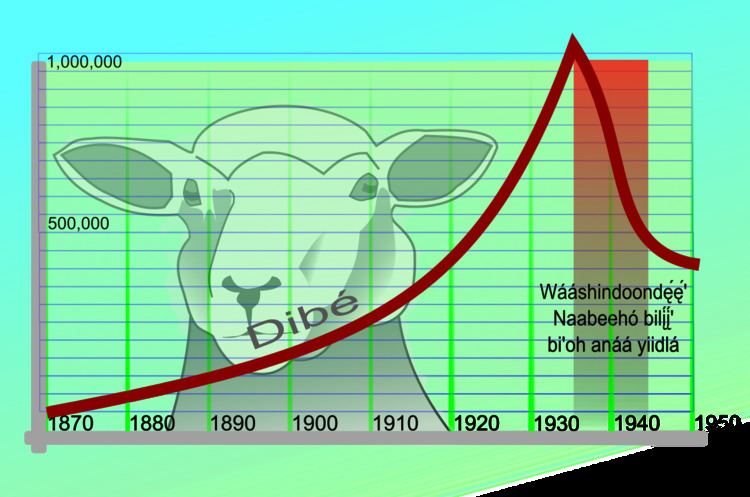 | ||
The Navajo Livestock Reduction was imposed by the United States government upon the Navajo Nation in the 1930s, during the Great Depression. The reduction of herds was conducted because grazing areas were becoming eroded and deteriorated due to too many animals.
Contents
Background
During the 1920s and into the 1930s, the Federal government decided that the land of the Navajo Nation could not support the increasingly large flocks of goats and sheep which people kept, together with their herds of cattle and wild horses. Land erosion was observed in many parts of the Nation. Erosion and inappropriate crop cultivation had left the Great Plains susceptible to erosion and dust storms, producing the Dust Bowl. Thousands of people left the Plains after their lands declined to sand. Many federal officials concluded that the only solution for the Navajo Nation was to drastically reduce the number of livestock.
In 1933, President Franklin D. Roosevelt appointed John Collier as Commissioner of what is now called the Bureau of Indian Affairs (BIA). He had long studied issues of Native Americans and hoped to improve their lives. Agreeing with bureau analysts, he concluded that the Navajo owned far too many sheep, goats, cattle and horses for the carrying capacity of their arid reservation. The capacity for sheep was about 500,000, but the people owned 2 million in 1931; the sheep provided half the cash income for the individual Navajo. Historians such as Lawrence A. Kuznar have noted that the analysis by Washington was quite thin, and dissent with its conclusions was suppressed.
Collier directed the purchase and removal of more than half of the livestock. Analysts did not understand the deep cultural ties the Navajo had to their herds. Many women suffered economically, often losing their only source of income. The Navajo became united in opposition to the program but, after Collier had opponents arrested, they were unable to stop it.
Historian Brian Dippie notes that the Indian Rights Association denounced Collier as a 'dictator' and accused him of a "near reign of terror" on the Navajo reservation. Dippie adds, "He became an object of 'burning hatred' among the very people whose problems so preoccupied him." The long-term result of livestock reduction was strong Navajo opposition to other elements of Collier's Indian New Deal. He encouraged tribes to re-establish their governments, ended allotment of communal lands, and encouraged revival of Native American cultures.
Navajo and sheep
The government established a quota for different types of livestock on specific areas of the reservation, claiming that areas had become overgrazed and risked erosion and damage. The government slaughtered a majority of the livestock it purchased in order to reach the quotas it established, without Navajo agreement. The livestock quota system is still being used today.
Spanish explorers and colonists had brought sheep and horses to North America and the Southwest for meat, wool, and transport. This was part of the Columbian Exchange, by which products, plants and animals were traded between the hemispheres. By the 18th century, the Navajo had adapted to these new animals, making use of them and developing their own flocks of sheep and herds of horses. In the 19th century, the government killed many of the herd animals after defeating the Navajo, whom they forced on the Long Walk and years as prisoners.
The United States government and Navajo signed a treaty in 1868 that returned the Navajo people to their traditional lands. Among the provisions of the treaty was giving each Navajo family two sheep, one male and one female, to start breeding their own herds again.
The Navajo were good shepherds and increased their number of livestock dramatically over the next 60 years. The government authorized increases in the size of their reservation, and stopped raiding and looting of the Navajo by outsiders. The Navajo marketed their wool both as a raw material and woven into Navajo rugs and blankets. The revenues they earned gave them incentives to increase the number of sheep; from 15,000 in the 1870s, the number rose to 500,000 in the 1920s.
The Navajo success with their livestock led to overgrazing. The federal government at first recommended that the numbers of livestock on the reservation be dramatically reduced. This went against many Navajo traditions, and destroyed a main source of income. For example, the Navajo considered their livestock sacred and integral to their lives. The chairman of the Navajo Tribal Council, Thomas Dodge, tried to present the government's arguments to the people. Because of the strong cultural and economic importance of the livestock, he was unable to sway most of the people.
After purchasing many animals, the federal government exterminated what amounted to more than 80% of the livestock on the reservation. The Navajo referred to these events as the Second Long Walk, because they were so destructive on their economy, society and way of life.
